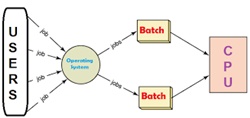
Table of Contents
Meaning of Batch Processing
The execution of transactions in a group or queue is known as batch processing. It is a technique for processing large amounts of data in a repeatable manner. Wherever processing resources are available, the batch processing method helps users to process data with little or no human intervention. It's best for end-of-cycle processing, such as processing a Bank's accounts at the end of the day or producing monthly or biweekly payrolls.

With batch processing, users collect and store data and then process the data during an event known as a “batch window.” This activity boosts productivity by prioritizing processing and finishing data jobs when it makes the most sense. Herman Hollerith, an American inventor who invented the first tabulating system, used the batch processing technique in the 19th century for the first time.
Advantages of Batch Processing
Better Data Reliability: Batch processing reduces the chances of failure by automating one or all elements of a processing job and minimizing user interaction. In order to improve data quality, precision and accuracy are improved.
Costs Benefit: When batch processing is used, operational costs, such as labour and machinery, are reduced. This is because it eliminates the need for individual clerks as well as physical hardware such as computers. Batch processing is often designed to be fast and effective. Also, it eliminates human error, meaning key employees can concentrate on their daily tasks.
Easy to use: Batch processing is a less complex method that does not need additional hardware or system assistance for data entry. Once established, a batch processing system needs less maintenance.
Availability: Batch processing devices, unlike others, can be used anywhere and at any time. This implies that they can even work in the background in an offline environment, so you can be assured that they'll keep working without disrupting the organization's daily operations.
Talk to our investment specialist
Disadvantages of Batch Processing
Training and Deployment: Batch processing devices, like many other technologies, necessitate some training. Managers would need to understand what causes a batch, how to schedule them, and what exception notifications mean, among other aspects.
Expensive: Investing in a batch processing system can be costly. The costs could seem unaffordable to certain companies running at a low scale.
Time-consuming: When a job lasts for too long, in the middle of the job, if an error occurs, then the entire work will be delayed for an indefinite period.
Examples of Batch Processing Systems
Payroll System
The batch processing system is more suited to payroll because it is convenient for estimating all workers' wages at the end of the month.
Bank Statements
It helps produce monthly statements for all the account holders.
Billing
Telecom company runs a monthly batch job to process Call data to calculate charges.
Daily Report
The batch processing system helps in generating daily reports for maintaining records.
Research Segment
To submit all batch systems, a researcher requires a high-scale, high-performance computing machine.
All efforts have been made to ensure the information provided here is accurate. However, no guarantees are made regarding correctness of data. Please verify with scheme information document before making any investment.












